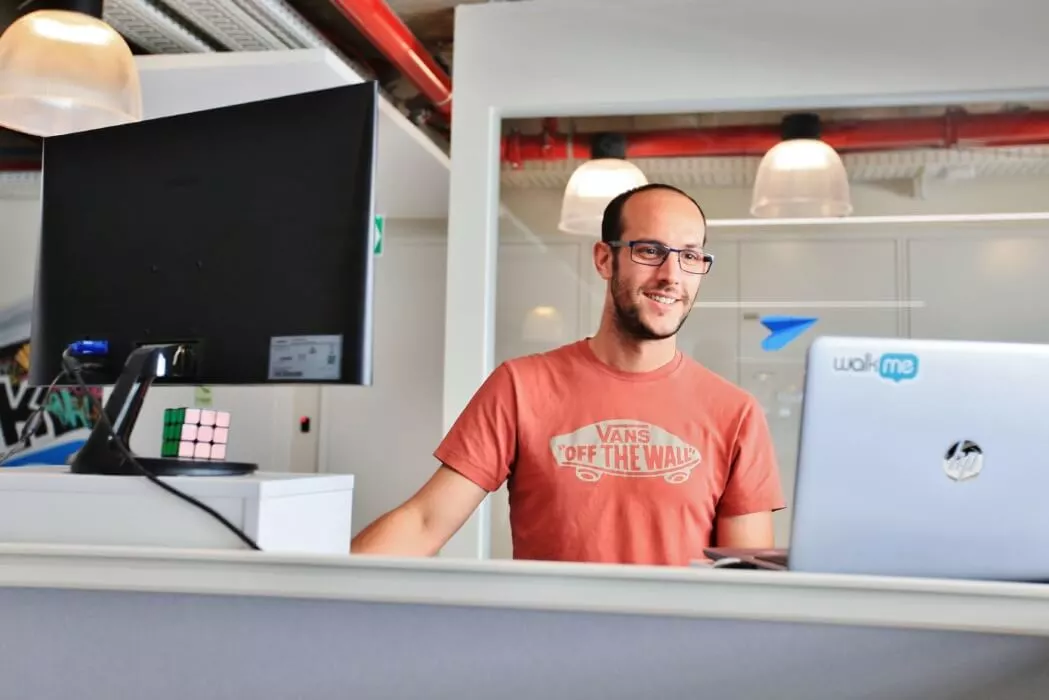How one information systems employee is driving the idea to make everything so simple, you might just miss it.
Behind every successful company there are talented, motivated and exceptional employees. In this exclusive series, we are giving you a sneak peek into the lives of the people who operate WalkMe.
WalkMe began as an idea for a simple solution to an everyday complexity that branched off into the company’s dream – to make everything online, instantly simple.
Each and every employee at WalkMe contributes to our vision. Whether we are dreaming up new additions to our original SaaS solution, or streamlining internal operations, the team at WalkMe works under one uniting goal — to make digital navigation as simple as possible for all users.
Omri, tell us a bit about yourself and your role at WalkMe.
Omri: I am a member of the information systems team at WalkMe. I have been working as a Salesforce Administrator, a system business analyst, during the course of my professional career. I have worked with Salesforce over the last few years — the ease with which it can help organize the data we use everyday, and better yet, use that data to then tell a story. It is a phenomenal concept.
Tell us more about what you and the team do to make WalkMe even more awesome. Which project are you most proud of?
Omri: Our team deals with many internal and external processes involving various systems, Salesforce being the most prominent. Recently, I developed and launched a customer survey that integrates seamlessly within our Salesforce platform. It makes the process of collecting, storing, sharing and analyzing user feedback easier than ever before.
Omri, Business Operations Engineer at WalkMe
Wow! Can you expand on what gave you and the team the idea to launch this new project? What kind of results did you see?
Omri: WalkMe’s philosophy has always been to make complex systems simple, this goes for internal operations, as well as our product. We wanted to optimize the process used by customer success and sales teams to collect feedback from WalkMe clients.
Before we implemented this project, customer success managers would use an external system and manually input the feedback they received. We saw room for improvement.
Now once a customer is live, a survey is automatically sent from Salesforce, and the feedback is pulled back in afterwards. There is almost no click interference. We can organize and filter the feedback to ensure customer success and analyze customer feedback to make updates to our product line.
You’re dealing with the implementation of many different software platforms. How do you approach a new system?
Omri: My first step is to gain an understanding of a new software’s main benefits and how they can complement our business requirements, in addition to reducing customer current pain points.
When you implement a new process, the hardest part is getting the user to actually include the changes in their daily flow.
“Reinforcing change with an end benefit to the user, is a much easier and more effective approach.”
I think that you just brought up one of the most common pain points in change management. How do you approach this resistance to change?
Omri: Have you ever read the book “Who Moved My Cheese?” It perfectly describes change in the workplace. As humans, we all have our own unique habits, and if something interferes with these habits, it may cause frustration. If users are unhappy with a new process they could reject the solution, which raises difficulties for our team during implementation. People will always look to defend their old ways, “the new process is not good… it’s not as effective.”
Instantly reduce resistance to change management by using WalkMe’s step-by-step onscreen guidance.
Trying to convince someone to use a new process or system without showing how it will help solve a greater problem, makes it hard to sell. Reinforcing change with an end benefit to the user, is a much easier and more effective approach.
Context is the name of our game at WalkMe. We have observed first hand that the best way to increase user adoption is through live support and contextual learning. WalkMe’s software guides our internal and external users through the implementation of new processes easily and painlessly every time.
“Be the person who users seek advice on how to solve a problem, not the person who needs to be told “how to fix a problem.”
You support many users with different backgrounds on different platforms. Any tips for people with the same role in other organizations?
Omri: I think ‘support’ is the wrong definition. I consider myself more of a consultant. As an administrator of software systems, you should understand your company’s processes better than anyone else.
Be the person who users seek advice on “how to solve a problem,” not the person who needs to be told, “how to fix a problem.”
![Introducing [Series]: WalkMe Through a Day in The Life](https://www.walkme.com/blog/wp-content/uploads/sites/2/2017/06/omri001_1200X627-725x460.webp)

